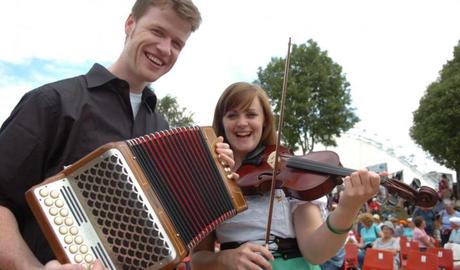 Accordions are used for playing different musical genres in mainstream and traditional music. In the continents of North America and Europe, most musicians confine these bellowed instruments within the boundaries of traditional, ethnic and folk songs. Popular styles like the Forró and Sertanejo in Brazil, and jazz, country, swing, blues, rock, etc., are also played with the help of accordions.
Accordions are used for playing different musical genres in mainstream and traditional music. In the continents of North America and Europe, most musicians confine these bellowed instruments within the boundaries of traditional, ethnic and folk songs. Popular styles like the Forró and Sertanejo in Brazil, and jazz, country, swing, blues, rock, etc., are also played with the help of accordions.
When the accordion was invented in 1829, the Europeans helped to spread it throughout the world by migrating to different continents in waves during the 19th and 20th centuries. The widespread popularity of accordions in Ireland, England, USA, Spain and many other countries was not due to a single reason, but rather for a combination of several factors. First of all, the instrument was loud enough to be heard even in the midst of the wildest crowds. It did not need to be tuned before playing and sounded just fine even in the hands of a novice. Gradually, people started to integrate it within different styles of traditional music such as the European polka, Korean trot, Colombian Vallenato, Irish ceol, Mexican Norteño, American Tejano, Austrian Schrammelmusik, etc. In fact, these are just a few names from the enormous list of countries where the accordions played a significant role in the realm of music.
From 1910 to the 1960, the preference of these bellowed instruments in mainstream music rose sharply. Even today, musicians in Brazil incorporate them in contemporary pop, thereby keeping its popularity undisturbed. Teenagers enthusiastically take lessons for learning how to play on accordions, which is quite synonymous with the craze for guitar-playing among adolescents in other countries. Although accordions are sometimes considered old-fashioned and bizarre in North America and Europe when used for playing mainstream pop, some artists like the popular viking metal and folk metal bands formed during the 90s and early years of the 21st century actually prefer them for their distinctive sounds.
The most noteworthy instance of accordion’s versatility is perhaps the fact that it has been employed even in classical pieces and live classical concerts. The oldest concert piece meant for playing on an accordion is the Thême varié très brillant pour accordéon methode Reisner, which was composed by Miss Louise Reisner in the year 1836. After her masterful attempt, many classical composers from countries like Austria, America, Russia and Italy walked the path treaded by her.

